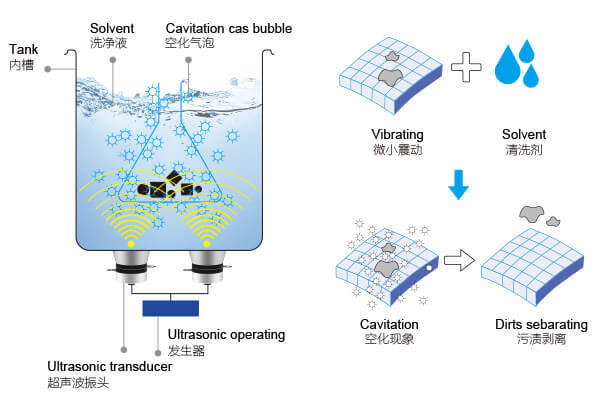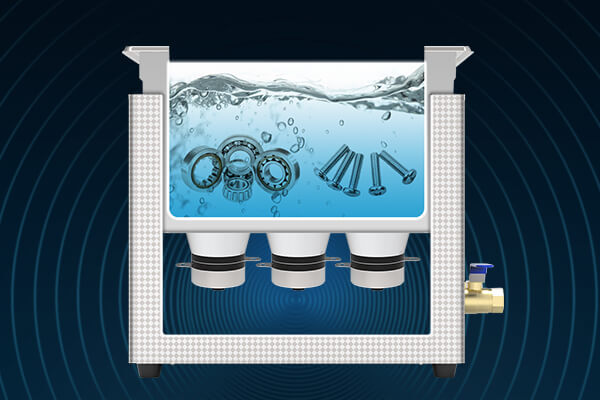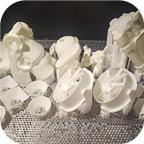Protect Your Valuables: Essential Guide to Ultrasonic Cleaner Safety
Browse Volume:93 Classify:Support
When I first encountered ultrasonic cleaning technology in my professional restoration workshop, I was amazed by its ability to remove years of accumulated grime from intricate objects. However, this powerful cleaning method isn’t suitable for everything. While ultrasonic cleaners have revolutionized cleaning processes across industries, from jewelry stores to medical facilities, using them incorrectly can lead to costly disasters.

The Principle Behind Ultrasonic Cleaning
The science behind ultrasonic cleaning is fascinating. These devices generate high-frequency sound waves, typically between 20-400 kHz, that create millions of microscopic bubbles in the cleaning solution. When these bubbles collapse, they release intense energy that effectively removes dirt and contaminants from surfaces. This process, known as cavitation, is what makes ultrasonic cleaners so effective – but it’s also why certain items can be damaged when exposed to this intense cleaning action.
Items You Should Never Put in an Ultrasonic Cleaner

The ultrasonic cleaner is cleaning the item(s)
Delicate Gems and Precious Stones: A Word of Caution
One of the most common mistakes people make is assuming all jewelry is safe for ultrasonic cleaning. While solid gold and platinum pieces generally handle ultrasonic cleaning well, many gemstones require more careful consideration. Emeralds, for instance, are particularly vulnerable due to their typical inclusion patterns and internal fissures. These beautiful green gems often contain natural inclusions filled with oils or resins, which can be displaced by the vigorous ultrasonic action, potentially compromising the stone’s appearance and value.
According to a study published in the Journal of Gemology (2023), approximately 23% of emeralds treated with ultrasonic cleaning showed signs of enhanced surface fracturing. Dr. Sarah Henderson, a leading gemologist at the International Gemological Institute, notes that “the risk of damage to treated emeralds in ultrasonic cleaners is significant enough that professional jewelers typically avoid this cleaning method altogether.”
Organic Gems: Nature’s Delicate Treasures
Pearls, coral, and amber represent another category of items that should never meet your ultrasonic cleaner. These organic gems have unique structures that make them particularly susceptible to damage from ultrasonic vibrations. Pearls, for instance, are composed of layers of nacre, which can delaminate under ultrasonic frequencies. Research conducted at the Pearl Research Laboratory in Tokyo demonstrates that even brief exposure to ultrasonic cleaning can reduce the luster of pearls by up to 15%.
Amber, being fossilized tree resin, contains microscopic stress patterns that can be exacerbated by ultrasonic vibration. A comprehensive study published in the International Journal of Conservation Science revealed that amber specimens exposed to ultrasonic cleaning showed increased internal fracturing and reduced structural integrity.
Electronic Components and Devices: The Hidden Risks
The relationship between electronics and ultrasonic cleaning requires particular attention. While some industrial-grade electronic components can withstand ultrasonic cleaning under strictly controlled conditions, most consumer electronics and sensitive components should never be subjected to this treatment. The same cavitation process that makes ultrasonic cleaning effective can wreak havoc on delicate electronic circuits and connections.
Dr. Marcus Chen, a senior researcher at the Electronics Manufacturing Research Institute, explains that “ultrasonic vibrations can create micro-fractures in soldered joints and compromise the integrity of integrated circuits.” His team’s 2024 study published in the Journal of Electronic Materials demonstrated that consumer-grade printed circuit boards exposed to ultrasonic cleaning showed a 47% increase in connection failures within six months.
Watches and Timepieces: Time-Honored Caution
Vintage and mechanical watches present another category requiring special consideration. While modern waterproof watches might withstand gentle cleaning, the intricate mechanisms of mechanical timepieces can be permanently damaged by ultrasonic vibrations. The delicate balance wheels, springs, and gear trains that make these masterpieces tick are particularly vulnerable.
The Swiss Watch Industry Research Institute reports that exposure to ultrasonic cleaning can alter a mechanical watch’s timing by up to several minutes per day. “The precision of a mechanical watch movement relies on perfectly calibrated components operating within microscopic tolerances,” explains master watchmaker Jean-Pierre Dubois. “Ultrasonic vibrations can disturb these tolerances irreversibly.”
Porous Materials and Textiles: The Absorption Problem
Materials with porous structures present unique challenges in ultrasonic cleaning. Fabrics, leather, wood, and certain types of plastic can absorb cleaning solutions in ways that make them nearly impossible to rinse properly. Moreover, the cavitation process can break down fiber structures and weaken material integrity.
A fascinating study conducted at the Textile Research Institute in Manchester found that natural fibers exposed to ultrasonic cleaning showed a 32% reduction in tensile strength after just one cleaning cycle. “The high-frequency vibrations can actually separate fiber bundles at a microscopic level,” notes Dr. Emma Thompson, lead researcher on the project. “This is particularly problematic for historical textiles and delicate fabrics.”
Antiques and Painted Surfaces: Preserving History
When it comes to antiques, the stakes are particularly high. Items with multiple components, such as antique furniture with joints or decorative inlays, can literally fall apart under ultrasonic vibration. Paint layers, especially on older items, can delaminate or flake off entirely.
The Conservation Institute of Historical Artifacts has documented numerous cases where well-meaning attempts to clean antiques using ultrasonic methods resulted in irreversible damage. A particularly notable example involved a 19th-century painted wooden box where ultrasonic cleaning caused complete separation of its hand-painted surface layer.
Composite Materials and Modern Items: Understanding Complex Structures
The world of modern manufacturing has given rise to an array of composite materials that require special consideration when it comes to cleaning methods. Items made from multiple layers or different materials bonded together can react unpredictably to ultrasonic cleaning. Take, for instance, laminated materials or items with protective coatings – the intense vibrations can cause delamination or separation between layers.
Consider your smartphone screen protector or a laptop’s protective coating. These seemingly robust materials are actually delicate sandwiches of different substances held together by adhesives. The cavitation process can work its way between these layers, much like water gradually eroding the banks of a river. Once this process begins, it’s nearly impossible to reverse the damage.
Medical Devices and Personal Care Items: Safety First
While ultrasonic cleaners are common in medical settings, not all medical devices can withstand this cleaning method. Particularly concerning are items with rubber or silicone components, such as hearing aids or certain types of prosthetics. The vigorous action of ultrasonic cleaning can cause these materials to deteriorate or change their physical properties.
Personal care items like electric toothbrushes, shavers, or water-resistant watches might seem suitable candidates for deep cleaning, but their waterproof seals can be compromised by ultrasonic vibration. Once these seals fail, the items become vulnerable to water damage and may pose safety risks to users.
Photographic Equipment and Optical Items: A Clear Warning
The relationship between ultrasonic cleaning and optical equipment is particularly problematic. Camera lenses, especially those with special coatings or multiple elements, can suffer irreversible damage. The same applies to eyeglasses with anti-reflective or UV-protective coatings. The microscopic vibrations can cause these coatings to separate from the lens surface, creating a cloudy or spider-web effect.
Even more concerning is the potential damage to items with optical adhesives, such as binoculars or telescopes. These precision instruments rely on perfectly aligned elements held together by specific adhesives. Ultrasonic cleaning can weaken these bonds, leading to misalignment and degraded performance.
Metals and Alloys: Not All That Glitters
While many metals can safely undergo ultrasonic cleaning, certain alloys and metal combinations require careful consideration. Soft metals like lead, or items with lead solder, can literally dissolve or deform under ultrasonic vibration. Similarly, items with plated surfaces – whether decorative or functional – may experience flaking or separation of the plating layer.
This is particularly relevant for vintage items or antique jewelry where the manufacturing methods and materials might not be immediately apparent. What appears to be solid gold might actually be gold-plated brass, and the ultrasonic cleaning process could reveal this fact in the most unfortunate way.
Stone and Mineral Specimens: Beyond Gemstones
The vulnerability of minerals to ultrasonic cleaning extends far beyond precious gemstones. Mineral specimens, whether collected for scientific study or display, often contain natural fractures, cleavage planes, and inclusions that make them susceptible to damage. Crystalline structures that appear robust can actually shatter along these natural weak points when subjected to ultrasonic vibration.
Desert rose formations, for instance, with their delicate petal-like crystal arrangements, can literally fall apart in an ultrasonic bath. Similarly, specimens with water content, like selenite or gypsum, may experience internal stress that leads to cracking or complete disintegration. The process is somewhat like subjecting a frozen pond to continuous mini-earthquakes – eventually, the structure will give way.
Vintage Musical Instruments: Preserving Harmony
Musical instruments, particularly vintage ones, represent another category where ultrasonic cleaning could spell disaster. The carefully calibrated acoustic properties of these instruments depend on specific material tensions and structural integrity. Wind instruments with cork joints, string instruments with hide glue joints, or keyboards with felt components can all suffer irreversible damage.
Consider a vintage saxophone with its intricate key mechanism, or an antique violin with its carefully aged varnish. The ultrasonic vibrations can loosen key springs, compromise cork seals, and even cause separation of wood joints that have held firm for centuries. The result isn’t just cosmetic damage – it’s a fundamental alteration of the instrument’s voice.
Heat-Sensitive Items: Temperature Concerns
One often-overlooked aspect of ultrasonic cleaning is the heat generated during the process. Even when starting with room-temperature solution, the cavitation process naturally produces heat. This can be particularly problematic for items made from temperature-sensitive materials or those with precise calibrations.
Plastic components, especially those from vintage items, can warp or become brittle. Calibrated scientific instruments may lose their accuracy. Even seemingly sturdy items like precision tools can be affected when their carefully maintained tolerances are disrupted by thermal expansion and contraction.
Ceramics and Glass: Hidden Weaknesses
While modern ceramics and glass often appear sturdy enough for ultrasonic cleaning, items with existing micro-cracks or stress points are at significant risk. This is especially true for antique porcelain, crystal, or art glass pieces. The ultrasonic vibrations can exploit these invisible weaknesses, turning minor flaws into catastrophic failures.
Art glass pieces with internal bubbles or decorative stress points are particularly vulnerable. The same forces that remove dirt can cause these intentional features to become failure points. It’s rather like repeatedly tapping a small crack in a windshield – eventually, the crack will spread.
Alternative Cleaning Methods: Safe Solutions
Given these numerous restrictions, what alternatives exist for cleaning delicate items? For most sensitive materials, traditional hand-cleaning methods remain the safest option. Soft brushes, appropriate cleaning solutions, and patience can achieve excellent results without risking damage.
For electronics, compressed air and specialized electronic cleaning solutions offer safe alternatives. Gemstones and jewelry can be cleaned using gentle soap solutions and soft brushes. Antiques often respond well to conservation-grade cleaning products specifically formulated for their materials.
Professional Cleaning Services: When to Seek Expert Help
Sometimes, the best decision is to consult professionals who specialize in cleaning specific types of items. Professional conservators, jewelers, and restoration experts have access to specialized cleaning methods and the expertise to choose the most appropriate approach for each item.
Guidelines for Safe Ultrasonic Cleaning: Making Informed Decisions
When considering ultrasonic cleaning, following a systematic evaluation process can help prevent costly mistakes. The first step is always to identify the material composition of the item in question. If an object contains multiple materials or if you’re unsure about its construction, it’s better to err on the side of caution and choose alternative cleaning methods.
Modern manufacturers often provide specific cleaning instructions for their products. However, these guidelines may not account for material degradation over time or previous repairs. A seemingly solid item might have hidden vulnerabilities that develop with age or use. Think of it like an old book – what starts as a minor weakness in the binding can become a serious structural issue under stress.
Testing and Preparation: The Critical First Steps
For items that appear suitable for ultrasonic cleaning, conducting a small test in an inconspicuous area can reveal potential problems before they become disasters. This is particularly important for items with multiple components or surface treatments. Monitor the test area for at least 24 hours to ensure no delayed reactions occur.
Temperature control is crucial during the cleaning process. Most ultrasonic cleaners should be operated between 40-60°C (104-140°F), but some materials require even lower temperatures. Using a thermometer to monitor solution temperature can prevent heat-related damage.
Understanding Frequency Settings
Different ultrasonic frequencies serve different purposes. Higher frequencies (around 40 kHz) are generally safer for more delicate items, while lower frequencies provide more aggressive cleaning action. However, even high-frequency cleaning can damage vulnerable materials over time. It’s similar to how a gentle breeze might seem harmless, but constant wind can eventually erode even solid rock.
The Role of Cleaning Solutions
The choice of cleaning solution is as important as the ultrasonic process itself. Using the wrong solution can cause chemical damage independent of the ultrasonic action. Water-based solutions are generally safest, but some materials require specific formulations. Always verify that both the cleaning solution and the ultrasonic process are appropriate for your item.
Best Practices for Safe Operation
When using an ultrasonic cleaner appropriately, certain practices can minimize risk:
- Never operate the unit without sufficient solution
- Position items so they don’t touch the tank bottom
- Use appropriate basket or suspension methods
- Limit cleaning time to the minimum necessary
- Monitor the process continuously
Professional Applications and Industrial Use
In industrial settings, ultrasonic cleaning plays a vital role in maintaining precision equipment and components. However, even in these applications, strict protocols must be followed. Professional cleaning operations typically involve:
- Regular calibration of equipment
- Detailed documentation of cleaning parameters
- Quality control checks before and after cleaning
- Specific training for operators
 Granbo Sonic
Granbo Sonic














